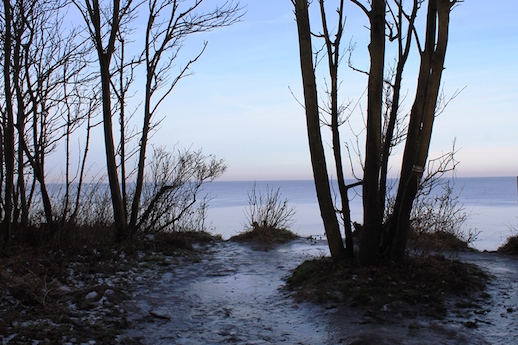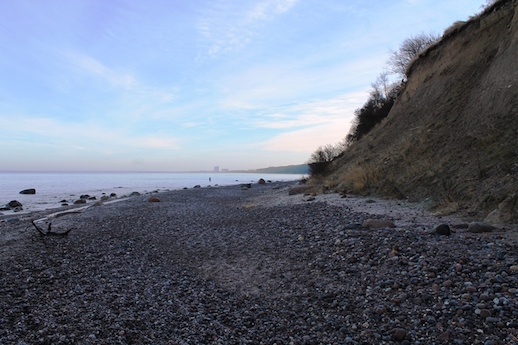 Photographs: Katrin Schönig. Words by Paul Scraton
Photographs: Katrin Schönig. Words by Paul Scraton
From the breakfast room we look out over frozen fields, a blue sky above a line of mist hanging just above the ground. The storm from last night has exhausted itself, and the mills of the windfarm are only turning gently. There is no other movement on the other side of the glass, until a sudden flurry of activity catches the eye. It is a crow and a sparrowhawk, flying from tree to tree, duelling as they go. Across the fields I can see the lines of neatly planted trees that mark the route of roads leading down to the beach. The Baltic is there, although we cannot see it. Just follow the path through a patch of woodland and you will find it; a clifftop lookout point above the sands and the still waters.
The Baltic is a bathtub.
That’s how my partner Katrin describes it as we emerge from the path through the woods and stand on the icy ground atop the cliff. The Baltic has long been described as such. Berlin’s bathtub. Hamburg’s bathtub. But it would be a brave Berliner or Hamburger to take to these waters today, on the second weekend of the year. The runners moving gingerly down the slippery path are wrapped up against the cold air, as are the walkers down on the sands. We move on, trying to find a route down to join them.
The cliffs of Stoltera lie roughly three miles west of the resort of Warnemünde, itself linked to the city of Rostock that stands on the banks of the Warnow river a little way inland from the sea. At the point where we first make it out onto the beach there is little sign of these large neighbouring settlements. They are hidden behind a promontory. In the other direction it is possible to guess at the identity of some of the towns on the shore – including Heiligendamm, Germany’s first seaside resort – but at this distance things are hazy, even through binoculars.
Instead we turn our attention to some white and black diving birds and the flock of Canada Geese passing by overhead. Further out to sea a huge tanker rests. BOTTIGLIERI written in enormous white letters on the side of the ship, readable with the naked eye. On my phone I type the letters into the search engine. A fleet registered in Naples, Italy. Even without clicking through to the website I know the company’s VAT number, phone and fax. The company, I read, specialises in the transportation of petroleum, iron ore and coal. I wonder what is resting today in the bowels of the boat, a mile or so offshore.
We walk west, towards the promontory. The sands have been blown by the winds and are frozen in place. The beach is a mixture of sand and various rocks and pebbles, somewhat unusual for a Baltic beach in this place of very little tidal movement and where debris on the sands is more likely to have been brought there over land than on the waves. The cliffs, we are warned, are unstable. DANGER OF DEATH reads the sign with various graphic representations of unfortunate stickmen in the wrong place at the wrong time. We continue past the sign, but walk closer to the water than the sandy cliff-face.

The cliffs at Stoltera retreat some 35 centimetres a year. A metre every three years. I calculate that by next winter they will have eroded five metres in the time I have been living in Germany. When they collapse, they bring the trees down with them. Some recent falls are still resting on the beach. Above us the cliffs curve, like a wave about to break. Other trees balance precariously on the lip, roots hanging down into the nothingness below, reaching for the beach that will one day break their fall. When a section of cliff collapses the diggers will appear, lifting the excess sand onto trucks to be taken to Warnemünde where it can be added to the vast expanse of sand that is northern Germany’s premier summertime playground.
Warnemünde comes into view as we round the promontory. The looming edifice of the Neptun Hotel, built in the GDR and fancied-up since the fall of the Berlin Wall to meet 21st century “wellness” requirements. We can see the lighthouses and, as if emerging from behind the buildings of the town, the ferry to Sweden easing its way from Rostock harbour along the Warnow to the open waters. The beach is now strewn with rocks and shells, the cliffs pockmarked with holes where the sandmartins nest. On a red stone, resting heavily on the sands, a dedication has been chiselled to one Eugen Geinitz. Once more to the phone, and Eugen Geinitz was a geologist, professor and University rector at Rostock. Much of his work centred on the geological studies of the Mecklenburg region of northern Germany. He must have spent a lot of time picking his way over these sands.
Today we have the beach pretty much to ourselves, although directly at the promontory we pass a young family as well as a couple. He is thigh deep in the water, casting his fishing line out. Perhaps he is the man known online as the Ostseefischer – the Baltic Fisherman – who has spent many happy hours here catching sea trout. As he wades ever deeper into the waters, our particular fisherman ignores a call from his wife who is standing by the fold-out chair and coolbox underneath the cliffs. Getting no reaction from offshore, she returns to staring morosely at her phone. She ignores us as we pass by, making our way to the steps up to the clifftop path and a route back to our home for the weekend. For us it is another day of exploration. For her another bitingly cold Saturday on the sands.
Paul Scraton is co-founder and Editor-in-Chief of Elsewhere: A Journal of Place. More about that here.